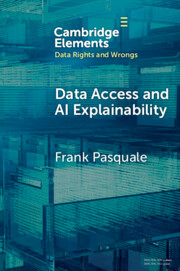Refine search
Actions for selected content:
2860 results in Computing and Society
Figures
-
- Book:
- Rethinking the Lawyers' Monopoly
- Published online:
- 04 September 2025
- Print publication:
- 18 September 2025, pp xi-xii
-
- Chapter
-
- You have access
- Open access
- HTML
- Export citation
6 - Civil [Justice] Engineering
- from Part II - Lessons from the Field
-
-
- Book:
- Rethinking the Lawyers' Monopoly
- Published online:
- 04 September 2025
- Print publication:
- 18 September 2025, pp 130-155
-
- Chapter
-
- You have access
- Open access
- HTML
- Export citation
Index
-
- Book:
- Rethinking the Lawyers' Monopoly
- Published online:
- 04 September 2025
- Print publication:
- 18 September 2025, pp 413-420
-
- Chapter
-
- You have access
- Open access
- HTML
- Export citation
5 - What Can Legal Services Reformers Learn from Court Efforts to Assist Self-Represented Litigants?
- from Part II - Lessons from the Field
-
-
- Book:
- Rethinking the Lawyers' Monopoly
- Published online:
- 04 September 2025
- Print publication:
- 18 September 2025, pp 107-129
-
- Chapter
-
- You have access
- Open access
- HTML
- Export citation
16 - Access to Advice as a Linchpin of Family Justice
- from Part IV - New Frontiers
-
-
- Book:
- Rethinking the Lawyers' Monopoly
- Published online:
- 04 September 2025
- Print publication:
- 18 September 2025, pp 370-389
-
- Chapter
-
- You have access
- Open access
- HTML
- Export citation
Contents
-
- Book:
- Rethinking the Lawyers' Monopoly
- Published online:
- 04 September 2025
- Print publication:
- 18 September 2025, pp vii-x
-
- Chapter
-
- You have access
- Open access
- HTML
- Export citation
9 - How Power Undermined the Medical Profession
- from Part III - The Comparative Lens
-
-
- Book:
- Rethinking the Lawyers' Monopoly
- Published online:
- 04 September 2025
- Print publication:
- 18 September 2025, pp 203-225
-
- Chapter
-
- You have access
- Open access
- HTML
- Export citation
10 - Lessons from Medicine’s Experiment with Nurse Practitioners and Physician Assistants
- from Part III - The Comparative Lens
-
-
- Book:
- Rethinking the Lawyers' Monopoly
- Published online:
- 04 September 2025
- Print publication:
- 18 September 2025, pp 226-257
-
- Chapter
-
- You have access
- Open access
- HTML
- Export citation
Part I - Framing the Issue
-
- Book:
- Rethinking the Lawyers' Monopoly
- Published online:
- 04 September 2025
- Print publication:
- 18 September 2025, pp 23-104
-
- Chapter
-
- You have access
- Open access
- HTML
- Export citation
14 - Professional Speech, the Lochnerized First Amendment, and the Unauthorized Practice of Law
- from Part IV - New Frontiers
-
-
- Book:
- Rethinking the Lawyers' Monopoly
- Published online:
- 04 September 2025
- Print publication:
- 18 September 2025, pp 319-347
-
- Chapter
-
- You have access
- Open access
- HTML
- Export citation
Part IV - New Frontiers
-
- Book:
- Rethinking the Lawyers' Monopoly
- Published online:
- 04 September 2025
- Print publication:
- 18 September 2025, pp 317-412
-
- Chapter
-
- You have access
- Open access
- HTML
- Export citation
17 - Putting Railroad Justice Back on Track
- from Part IV - New Frontiers
-
-
- Book:
- Rethinking the Lawyers' Monopoly
- Published online:
- 04 September 2025
- Print publication:
- 18 September 2025, pp 390-412
-
- Chapter
-
- You have access
- Open access
- HTML
- Export citation
Introduction
-
-
- Book:
- Rethinking the Lawyers' Monopoly
- Published online:
- 04 September 2025
- Print publication:
- 18 September 2025, pp 1-22
-
- Chapter
-
- You have access
- Open access
- HTML
- Export citation

Data Access and AI Explainability
-
- Published online:
- 12 September 2025
- Print publication:
- 02 October 2025
-
- Element
-
- You have access
- Open access
- HTML
- Export citation

Killing the Messenger
- The War on Social Media
-
- Published online:
- 05 September 2025
- Print publication:
- 25 September 2025
-
- Book
-
- You have access
- Open access
- Export citation

Rethinking the Lawyers' Monopoly
- Access to Justice and the Future of Legal Services
-
- Published online:
- 04 September 2025
- Print publication:
- 18 September 2025
-
- Book
-
- You have access
- Open access
- Export citation
5 - Right of Publicity and Deepfakes
- from Part II - Hot Topics in AI and IP
-
- Book:
- AI versus IP
- Published online:
- 09 August 2025
- Print publication:
- 28 August 2025, pp 68-72
-
- Chapter
- Export citation
Part IV - Pathways Forward
-
- Book:
- AI versus IP
- Published online:
- 09 August 2025
- Print publication:
- 28 August 2025, pp 111-129
-
- Chapter
- Export citation
Part III - The Deeper Problem for IP
-
- Book:
- AI versus IP
- Published online:
- 09 August 2025
- Print publication:
- 28 August 2025, pp 73-110
-
- Chapter
- Export citation
Contents
-
- Book:
- AI versus IP
- Published online:
- 09 August 2025
- Print publication:
- 28 August 2025, pp vii-viii
-
- Chapter
- Export citation
